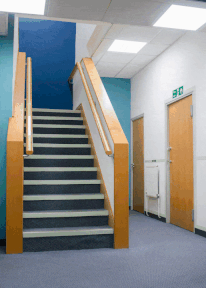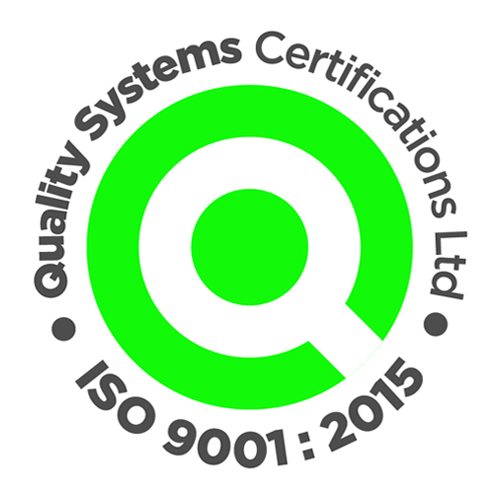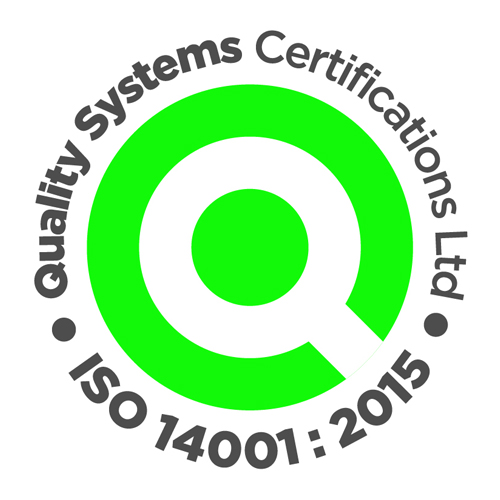
Low Location Lighting
We offer five different formats to fulfil photoluminescent Low Location Lighting requirements and we also have related products, such as kick-plates, safety rails, stair nosing tactile aids etc.

Our Low Location Lighting Systems:
- Telscape™ LLL SWGs
- Telscape™ Enclosed Carrier
- Telglow™ Opaque LLL Carrier
- Telglow™ Rigid 2.5mm Strips
- Angled Aluminium Carrier
Why Telglow™ Photoluminescent material?
When mains illumination fails, exit routes must be lit adequately. Properly energised Telglow™ material will show the way better by aiding orientation and providing direction. Telglow™ costs less to install than an electric system and has little or no maintenance. It presents no fire risk and is less likely to be vandalised.
1) Telscape™ LLL Carrier
Maritime Progress Limited has developed a safety way guidance system (SWGS). All components are produced in-house and therefore we can offer our customers an economic system, that is not only aesthetically pleasing but is also easy to install and can assist with deck/level orientation via different colour carriers.
These products consist of a 5mm thick strong PVC carrier with rounded edges compatible with Parts Nos 2338 and 2330 end caps. Available in two widths, 70mm (product code 2327) or 60mm (product code 2329). There is a central channel to fit a strip of Telglow™ photoluminescent material.

2) Telscape™ Enclosed Carrier
It is our experience that some vessels have wall runs (ribs) which are punctuated with doors and service ducts/columns and the installation is easier if the carrier is enclosed and completed to a given size(s). Also there are colour co-ordinated sign holders that can be matched to the escape route carrier to add quality to the installation.

3) Telglow™ Opaque LLL Carrier
A simpler option of carrier is offered, which allows a 50mm B class material to slide into the 2m length carrier, after it has been secured to the wall. The advantage of this form of installation is that only the Telglow™ material is 100% visible, while the material is protected by the carrier.

Part No: 2396Z – Transparent carrier (2m length)
Part No: 2389Z – Rigid photoluminescent (50mm x 1m)
4) Telglow™ Rigid 2.5mm Strips
The simplest option is to screw and adhere 50mm, or 30mm width rigid Telglow™ material directly to the wall of the escape route walkways. Some are supplied in 1.2m lengths.

Part No: 2331Z – 50mm width – Class B
Part No: 2332Z – 30mm width – Class D
5) Angled Aluminium Carrier
Consisting of an aluminium carrier extrusion with a rigid photoluminescent PVC insert, which provides a quick and easy installation, combined with rugged and durable quality.
We can supply in two sizes, which offer a 50mm visible width of Class B photoluminescent rigid, or 35mm Class C photoluminescent strip.
The carrier is angled away from the vertical to allow the photoluminescent panel to catch more ambient light. The photoluminescent performance of the rigid panels is certified by Lloyds Register as exceeding IMO requirements when charged with less than 30 Lux from a fluorescent source.

Part No:-
2394Z – 50mm angled carrier 60x3000mm
2395Z – 50mm angled carrier end cap
2374Z – 35mm angled carrier 42x3000mm
2375Z – 35mm angled carrier end cap
Installation – carriers are fixed to the bulkhead by countersunk screws, the heads being covered by the photoluminescent panels, which are simply slipped into the extrusion. Internal and external corners, and drops up and down stairways, are made easily by mitring the extrusion and cutting the photoluminescent panels to suit.
LLL signs should be used to give direction indication (LLL signs can be found in the product listing: Low Location Lighting > Compatible signs). End caps are available to terminate the extrusion neatly, where required.
Telscape™ Kick-plates
The purpose of these plates are to protect décor at floor and/or other levels which may be subject to damage from trolleys, luggage, movements of beds and furnishings etc.,
Part No. 2325 – 170 x 1200mm (with Class B Telglow™ insert)
Part No. 2326 – 170 x 1200mm (without Telglow™ insert)

Part No. 2326 will incorporate a 50mm Telglow photoluminescent strip which fulfills low location way guidance to aid escape in the event of blackouts (a factor that could also arise in terrorist attacks).
Safety Rail
The ISO 15370 : 2011 recommends the placement of way guidance system at 300mm from the deck enabling people in severe smoke condition to escape, by leaning forwards toward the floor, to see the escape route marking. There is another school of thought that prefers a safety rail system 1m off the floor incorporating, signs and tactile directions.

2333 – Carrier 90mm with 50mm Class B insert
LLL System requirements
The system should be installed in accordance with the Fire Systems Safety Code.
If required by legislation then all escape routes, including stairs, must be marked by Low Location Lighting.
Where a photoluminescent material is used this should be a minimum of 75mm wide, unless the photoluminescent performance is increased to allow a narrower width, as is the case with the Maritime Progress systems.
Reference should be made to ISO 15370 Annex D as amended, for required performance at reduced widths. The strip should be positioned no higher than 300mm from deck level.
Where stairs or corridors are more than 2m wide, LLL strips should be provided on both sides. Stairs should have the top and bottom clearly identified with signs 2384 or 2385 applied to the strip.
‘Dead end’ passages should be marked with arrows (signs ref. 2382 or 2383) spaced no more than 1m apart to direct people away from the dead end.
The photoluminescent strip should be run up vertically to the handle of each door, which forms part of the escape route. ‘Exit’ signs 2386 or 2387 should be provided at each exit, located on the same side as the door handle. Fire and watertight doors should be marked to show how the door opens.
All photoluminescent material must produce at least 15 mcd/m2 for 10 minutes after removal of external light sources, and at least 2 mcd/m2 after 60 minutes, when tested in situ. The installer should ensure that sufficient light is available to activate the photoluminescent material to attain this performance.
Systems should have their luminescence tested at least once every five years.
Regulations
As identified in SOLAS, Chapter II-2, Regulation 13.3.2.5.1 to 13.3.2.5.2 and Chapter II-1, Regulation 42 and 42-1 as appropriate, ships carrying passengers will be fitted with electric, or photoluminescent Low Location Lighting and if carrying more than 36 passengers these regulations also apply to the crew accommodation.
Reference should also be made to IMO Resolution A.752 (18) for the evaluation, testing and application of Low Location Lighting.
For further information on our LLL systems and associated products contact info@maritimeprogress.com



